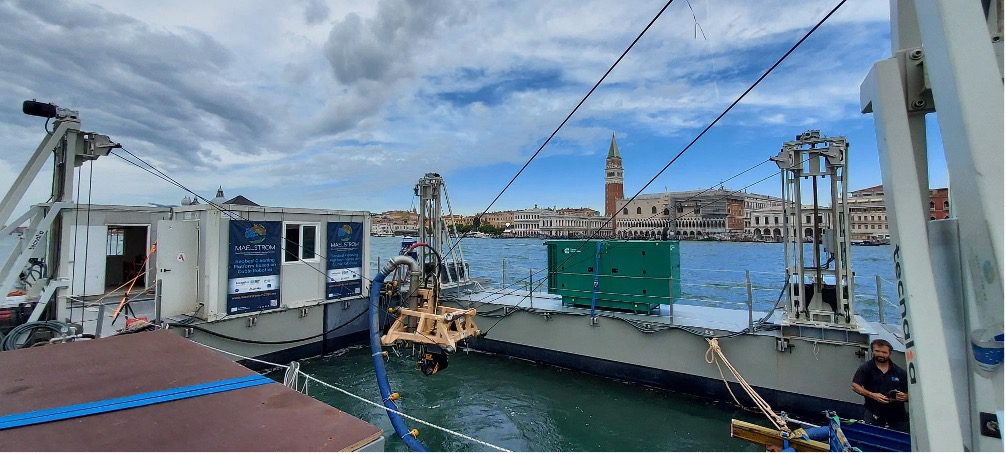Cleaning operations of our Robotic Seabed Cleaning Platform for Marine Litter Removal have started in Venice

Cleaning operations have begun in the Venice Lagoon to test the Robotic Seabed Cleaning Platform for Marine Litter Removal developed as part of our EU-funded H2020 project. From Sept. 15 to Sept. 30, an international team coordinated by CNR-ISMAR is testing the robotic platform near the island of Giudecca and in Cavallino Treporti, both areas particularly affected by underwater litter. The operations are being conducted in collaboration with the City of Venice, the Venice and Jesolo Coast Guards, the Veritas Group and in agreement with the Water Authority and the Veneto Region.
The Robotic Seabed Cleaning Platform for Marine Litter Removal was developed by MAELSTROM’s partners Tecnalia (Spain), CNRS-LIRMM (France) and the Venice-based company Servizi Tecnici and consists of a floating barge to which, through cables and winches, the seabed cleaning robot is attached.
“Our robot is equipped with artificial intelligence-guided sensors to monitor the seabed and identify litter. Two different tools allow for the collection of material of different sizes: a suction tube for smaller waste and a grapple for larger ones such as tires, abandoned fishing nets and boat parts,” explain Damien Sallé and Mariola Rodriguez from Tecnalia.
“The seabed cleaning platform takes advantage of the unique capabilities of cable-driven robots in terms of payload mass and workspace size in order to pick and remove from the seabed relatively large and heavy objects, such as tires” explains Marc Gouttefarde, from CNRS-LIRMM.

The robotic platform is designed to work up to a depth of twenty meters without damaging aquatic ecosystems and it can be operated either autonomously or with the guidance of a remote operator.
“Venice has been chosen as the location for operational testing of the platform due to the coexistence in the Lagoon with several logistical assets: the Commercial Port with deep sea canals and the Historic Center with canals with reduced water head. Both are characterised by multiple environmental issues that need to be addressed and which will enrich the database of technologies supported by Artificial Intelligence procedures. The combined effects of tidal currents, different types of traffic, complex mooring conditions, not always optimal visibility, heterogeneity of the litter, differentiation of the drawdown system and precision positioning on digital maps were analyzed, processed, and efficiently resolved by the operations team on board,” explains Nicola Ferrari, CEO of ST.
“The operations that have begun are the first opportunity to test the system in the field. The waste recovered by the robotic platform, after an initial assessment of its type and weight, will be disposed in different ways, depending on its composition and state,” add Damien Sallé and Giorgio Betteto of GEES Recycling, a partner in the project.
MAELSTROM, in fact, is not only implementing technologies for the collection of marine litter, but it also intends to contribute to its recycling within a circular economy perspective, as envisaged by the European Strategy on Plastics in the Circular Economy. In addition, all removal and disposal operations, including those during the testing phases, will be tracked through the MAELSTROM App, developed last spring by GEES Recycling and designed to follow the waste at every stage, from collection to recycling, so to make the entire process as transparent and complete as possible.
“By being carried by currents, marine litter – mainly represented by plastics – reaches every area of the planet, contaminating ecosystems, harming animals and putting our own health at risk,” comments Fantina Madricardo, CNR-ISMAR researcher and project coordinator. “Helping to address this global challenge is the ultimate goal of MAELSTROM, a project that brings together fourteen partners from eight different countries. The approach is not only technological: beyond the tools that science allows us to develop the project includes several events and opportunities to meet and inform citizens and civil society at large, such as the recent clean-up event held in Portugal during the World Clean Up Day, to encourage everyone’s involvement and awareness. This is everyone’s mission!”